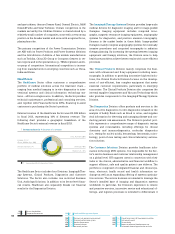Siemens 2013 Annual Report Download - page 162
Download and view the complete annual report
Please find page 162 of the 2013 Siemens annual report below. You can navigate through the pages in the report by either clicking on the pages listed below, or by using the keyword search tool below to find specific information within the annual report.
92 A. To our Shareholders
117 B. Corporate Governance 155 C. Combined Management Report
156 C. Business and economic environment
173 C. Financial performance system
179 C. Results of operations
192 C. Financial position
204 C. Net assets position
207 C. Overall assessment of the economic position
209 C. Subsequent events
210 C. Sustainability
227 C. Report on expected developments and
associated material opportunities and risks
Results for prior periods are reported on a comparable basis. In
November , Siemens announced the sale of this business.
The transaction is subject to regulatory approval.
The Industry Automation Division offers a range of standard
products and system solutions for automation technologies
used in the manufacturing and process industries. As one of
the leading providers of industry software, the Division can
help manufacturing companies optimize their entire value
chain: from product design and development, through pro-
duction, to sales and service. The Division’s offerings include
automation systems and software, motor controls, machine-
to-machine communication products, sensors, product and
production lifecycle management products, and software for
simulating and testing mechatronic systems. In fiscal , the
Division acquired LMS, a provider of mechatronic simulation
software that expands and complements the Division’s prod-
uct lifecycle management portfolio.
As noted above, the di-
vestment of the mechanical, biological and chemical water
treatment business was decided in fiscal and this busi-
ness is reported as discontinued operations for all periods
covered in this Annual Report. The sale of this business,
which is subject to regulatory approval, was announced in
November .
The Drive Technologies Division offers products and compre-
hensive systems across the entire drive train. These offerings
are customized to the respective application and include nu-
merical control systems, inverters, converters, motors (geared
and gearless), drives and couplings. In addition, Drive Technol-
ogies supplies integrated automation systems for machine
tools and production machines. The Division also offers inte-
grated lifecycle solutions and services for industries such as
shipbuilding, cement, mining, and pulp and paper. With its
e-Car business, the Division develops motors and inverters for
electric cars.
The Customer Services Division offers a comprehensive port-
folio of services and supports industrial customers in their
efforts to increase their productivity. The portfolio includes
product-related services and software solutions like condition
monitoring designed to enhance the reliability, profitability,
efficiency and environmental performance of industrial plants.
The Sector-led Metals Technologies Business Unit offers
engineering and plant-building services for the iron and steel
industry, and for the rolling sector of the aluminum and
non-ferrous industries. The Business Unit provides technolo-
gies, solutions, and services for metallurgical plants, integrat-
ed steelworks and minimills. Its vertically integrated supply
capability includes mechanical equipment, drives, motors,
electrics, automation, mechatronics, technological packages
and environmental systems.
The Industry Sector’s principal customers are industrial cus-
tomers in a broad range of markets, including transportation
and logistics, metals and mining, machinery, utilities and
automotive. The Sector is active worldwide, including in
emerging markets, especially those in the Asia, Australia re-
gion, which Sector management believes to have long-term
growth potential. Apart from the Siemens brand, the Sector
markets some parts of its portfolio under different brand
names (such as Flender for gears or Winergy for wind turbine
components) depending on geography and technology.
The Sector sells its products primarily through dedicated
personnel in Siemens’ worldwide network of regional sales
units. In addition, it uses original equipment manufacturers,
solution providers, installers, general contractors, third-party
distributors and independent agents.
The Sector has manufacturing locations worldwide, especially
throughout North and South America, Western and Eastern
Europe, and Asia, allowing it to stay close to its major custom-
ers. In recent years, material costs have been subject to signifi-
cant price volatility for metals, energy and other raw materials.
The Sector continues to work on reducing the use of hazard-
ous materials (e.g., lead) and to replace them in its products
and processes. Sustainable products and processes, such as
coking coal free iron production processes (COREX), energy
efficient motors and energy management play a major role in
its innovation strategy.
Product lifetimes in the Sector’s product businesses typically
range from three to twenty years from introduction. Lifecycles
tend to be shorter for products in which software and electron-
ics play an important role. The lifecycles in the solutions busi-
nesses tend to be longer, as the Sector supports its customers
with significant services through the whole life of their invest-
ment. The Industry Sector can be strongly affected by econom-
ic cycles, because markets for some of its business activities
tend to react very quickly to changes in the overall economic
environment. This pattern includes many of the business
activities of the Industry Automation Division and those busi-
ness activities of the Drive Technologies Division that serve
customers in the manufacturing industries. The markets for
other business activities within the Sector generally show a
more delayed response to changes in the overall economic
environment. This pattern includes those business activities of
the Drive Technologies Division that serve customers in
























